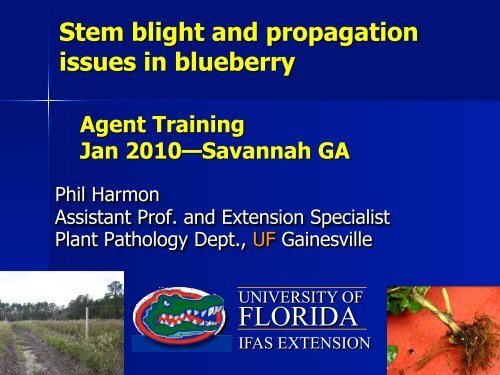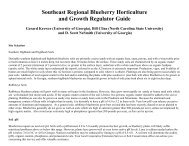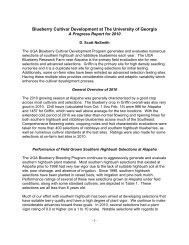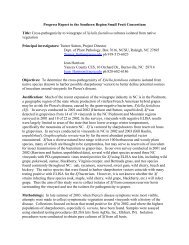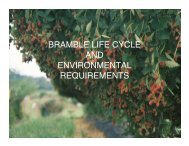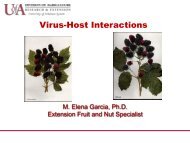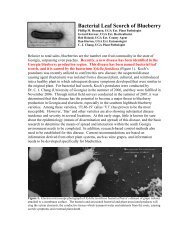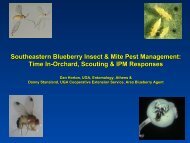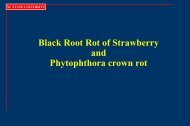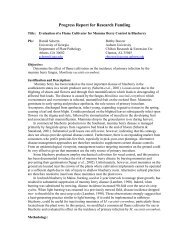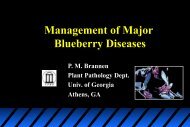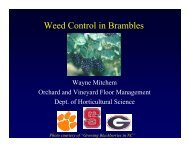Stem Blight and Propagation Issues in Blueberry
Stem Blight and Propagation Issues in Blueberry
Stem Blight and Propagation Issues in Blueberry
Create successful ePaper yourself
Turn your PDF publications into a flip-book with our unique Google optimized e-Paper software.
<strong>Stem</strong> blight <strong>and</strong> propagation<br />
issues <strong>in</strong> blueberry<br />
Agent Tra<strong>in</strong><strong>in</strong>g<br />
Jan 2010—Savannah GA<br />
Phil Harmon<br />
Assistant Prof. <strong>and</strong> Extension Specialist<br />
Plant Pathology Dept., UF Ga<strong>in</strong>esville<br />
UNIVERSITY OF<br />
FLORIDA<br />
IFAS EXTENSION
Two Symptoms<br />
n Flagg<strong>in</strong>g symptom reduces yield <strong>and</strong><br />
plant vigor<br />
– Requires h<strong>and</strong>-prun<strong>in</strong>g to remove diseased<br />
wood<br />
n Crown <strong>in</strong>fection reduces vigor <strong>and</strong> kills<br />
plants just as they start to become<br />
productive<br />
– Requires replant<br />
– Lost establishment <strong>in</strong>vestment<br />
– Lost yield profit
stem blight<br />
Discoloration under the bark at<br />
the crown of plants with dieback
Botryosphaeria fungi
Mature conidia of B. obtusa <br />
Mature conidia of L. theobromae <br />
Mature conidia of F. aesculi (B. dothidea) <br />
Mature conidia of N. ribis
10 to15% of<br />
‘Snowchaser’ cutt<strong>in</strong>gs<br />
developed stem blight
16<br />
Snowchaser cutt<strong>in</strong>gs from W<strong>in</strong>dsor, FL. 2009<br />
14<br />
Percent stem blight<br />
12<br />
10<br />
8<br />
6<br />
4<br />
2<br />
0<br />
6/2 6/16 7/1 7/20 8/11 9/9 9/23
Latent <strong>in</strong>fection or external contam<strong>in</strong>ant<br />
Leaves <strong>and</strong> stems washed for 2hrs.<br />
Lisate was filtered onto sterile filter paper <strong>and</strong><br />
placed onto PDA with rif <strong>and</strong> amp.<br />
Leaves <strong>and</strong> stems were surface sterilized with<br />
bleach <strong>and</strong> then plated
Number of Bot. colonies recovered from lisate <br />
Date No. Colonies B. obtusa L. theobromae N. ribis Unknown <br />
5/20/10 0 -‐ -‐ -‐ -‐ <br />
6/30/10 0 -‐ -‐ -‐ -‐ <br />
7/28/10 1 -‐ 1 -‐ -‐ <br />
8/28/10 1 -‐ -‐ 1 -‐ <br />
9/28/10 6 -‐ 2 2 2 <br />
Number of Bot. colonies recovered from surface sterilized swc <br />
Date No. Colonies B. obtusa L. theobromae N. ribis Unknown <br />
5/20/10 1 1 -‐ -‐ 0 <br />
6/30/10 6 -‐ 1 3 2 <br />
7/28/10 7 -‐ -‐ 4 3 <br />
8/28/10 7 -‐ -‐ 6 1 <br />
9/28/10 10 -‐ -‐ 9 1
<strong>Propagation</strong> methods 2009-10<br />
Total <strong>Stem</strong> blight Percent<br />
Alachua Co.<br />
SW 22 14 63%<br />
TC 17 4 2%<br />
Total 39 18 45%<br />
DeSoto Co.<br />
SW 242 234 96%<br />
TC 43 35 81%<br />
Total 285 269 94%<br />
Polk Co.<br />
SW 49 35 71%<br />
TC 6 1 2%<br />
Total 55 36 65%
Average number of dead plants per plot at Arcadia, Fl <br />
Average number of dead plant per plot <br />
20 <br />
18 <br />
16 <br />
14 <br />
12 <br />
10 <br />
8 <br />
6 <br />
4 <br />
Premaddona (SW) <br />
Premaddona (TC) <br />
Snowchaser (SW) <br />
Snowchaser (TC) <br />
Emerald (SW) <br />
Emerald (TC) <br />
Jewel (SW) <br />
Jewel (TC) <br />
2 <br />
0 <br />
12/18/2008 3/28/2009 7/6/2009 10/14/2009 1/22/2010 5/2/2010 8/10/2010 11/18/2010
Management strategies<br />
(general)<br />
n Choose clean plant material for propagation.<br />
n Prune out blight <strong>and</strong> remove diseased plant material from<br />
the field—remove plants with severe dieback. They<br />
cannot be cured.<br />
n Manage irrigation carefully to prevent water stress.<br />
n Do not allow young plants to overproduce berries <strong>in</strong> the<br />
first few years.<br />
n Fungicides used to manage fruit rots, leaf spots, <strong>and</strong><br />
other foliar diseases may help with this disease by<br />
reduc<strong>in</strong>g stress, especially <strong>in</strong> nursery situations.<br />
n Use less-susceptible cultivars<br />
n Fungicide use at prun<strong>in</strong>g
Management strategies<br />
n More on fungicides<br />
– Applications <strong>in</strong> fall 2006 did not prevent plants<br />
from dy<strong>in</strong>g through Fall 2007.<br />
– Prun<strong>in</strong>g out disease <strong>in</strong> the plots did not reduce<br />
the number of plants that died<br />
– Increased fall fertility did not affect rate of<br />
plant death<br />
n Marg<strong>in</strong>al reduction <strong>in</strong> disease observed<br />
when applications made same day as<br />
prun<strong>in</strong>g
GH trial
GH trial
Field trial<br />
A<br />
B<br />
B<br />
B<br />
B
Thanks. Questions<br />
Phil Harmon<br />
pfharmon@ufl.edu


